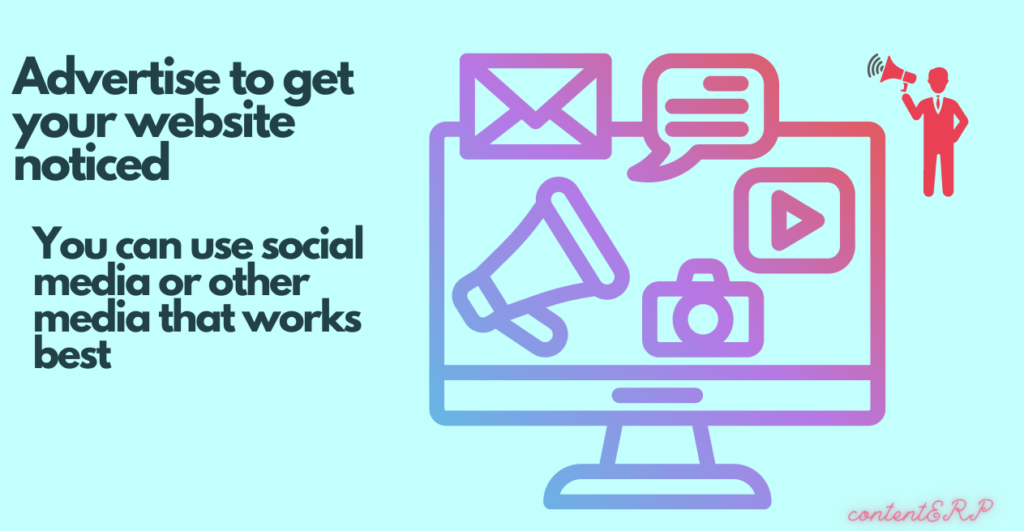The best way to get your website noticed

Introduction
The first place people look for just about anything is the internet, and as a business with an online presence, how do you get your website noticed?
Today, search engines are the window to billions of people’s lives. Having a strong presence on the web is one of the first things people will want to check out when searching for whatever they want. This puts a lot of pressure on web businesses to get found, which is why it’s important to work on making your content findable for everyone.
Get Your Website Noticed
To be SEO-friendly, your site’s content needs to fill five main criteria, but you should also work on other promotion-oriented criteria, such as emailing and social networking.
The way every link or popular page on your site (even if you’re using a backlink building site) is linked to search engine results is vital to your search engine rank.
You only want to fill a certain number of pages on your site with valuable, gated results. This way, you can easily verify if a spider marked your web pages as unique content. You should run the latest gated crawling check on your favorite backlink building platform, like Open Site Explorer.
Optimize Your Search Engine Ranking
Okay, so you want a simple way to help your site rank higher on Google and other search engines. Conducting a quick and efficient SEO audit will allow you to gear your efforts towards first things first, developing a strong and well-linked, expert-checked Google Marketing Campaign.
Use extensive keyword analysis and then focus your efforts on three areas.
Website optimization- Make Google happy and assume your site is clean
Quality Assurance- Have the appropriate procedures and tools in place to minimize “bot” crawling
Content optimization -Use relevant keywords and, where applicable, bring in guest blogging to develop trusted backlinking.
Advertise (SEO)
The search engine optimizer’s role is to ensure that a website achieves high rankings on Google or any other search engine results page (SERPS). (Sometimes, this is also referred to as search engine marketing or SEO).
Search engine optimizers work on improving, enhancing, and optimizing websites so that they receive higher rankings.

All parts of a website that offer users something of value are highly valuable to search engine providers. These parts include:
- Title & paragraph tags
- Header tags & image alt metadata.
- Include a well-formatted H1 tag for the first page in Google.
- A well-formatted H2 tag detailing the content or services and then the rest of the page.
- Cite the podcast, vlogs, movies, or TV show your site originates from
Quality content
Higher SEO rankings require great, convincing content. Content that caters to the user’s needs and answers their most pressing query in a simple, clear, and straightforward way.
Google uses very sensitive algorithms to achieve a high ranking for a website. This means that you must create more and more content around your main keywords to provide more of an opportunity for your website to be found.
For example, if you own a retail-based business, it would make sense to put more and more of these keywords in consistent link-building content on your website when you complete necessary updates for content changes over time.
Search Engine Optimization
To get a strong online presence, your website must be optimized for search engine results pages like Google, Bing, or Safari.
Yep, the SERPs can be really favorable for businesses.
Creating a compelling offer can transform a weak website into a powerful marketplace. If you don’t have compelling value, you may not have invested in sufficient value, or you may not have emphasized your value too much or at all.
While it’s under your control to set up your website, the search engine results pages (SERPs) determine your website’s rank and where people land when they hit search criteria.
This means the more time you put into SERPs, the more visitors you can attract to your website, and you will stand to earn more money through your business.
Focus on visual content
Designing with visual content in mind is an important step in the process. Determine what content makes your site more engaging and then design accordingly. Whether your site’s goal is informational, educational, or sales-focused, the design should be high quality and visible. The Google Home page is a great example of this.
Editing Your Page Titles and Meta Descriptions

Let’s say you are gathering your products to list on the eCommerce platform that you are about to create: a fashion store, a celebrity store, crafts, etc.
Search the web for the things you need, like a bread recipe, a summary of the newly released movie, a list of IPAs, or a recent successful vote in the elections.
For each product, create a landing page. Each page will receive help for the specific keyword and more than one product, so each has its own title, description, keywords, and link.
When you renew your eCommerce platform, ensure that all the links address each keyword’s most profitable pages.
Editing Your Content
Search engines like Google, Yahoo, and Bing crawl the web looking for websites. When they find a website that provides a service or sells a product, they list the domain on a scaled ranking.
Search engines now create allowlists and blocklists of websites that contain spam. If your website is on the blacklist, it gets an automatic penalty. This reduces the ranking of their websites. They send you a warning message when your website is on their block list.
You can get back on par as soon as you take action, and the message goes away. However, this doesn’t happen overnight. It can take several months for this process to complete.
This means that the earlier you make a change, the more leeway you have to get back into a positive rank. This is why content is one of the most important steps unless you want penalties on your site.
While earning a link is hard, it seems easier if you do it for a highly ranked website. Getting a link from a highly ranked website means you are past the black hat SEO tactics, becoming more of an authority. This works better if you have articles to show people. Article sales rank.
Start a Blog
Starting a blog for your website is one of the fastest ways to get your website noticed. A blog is hands down the best way to increase your website’s organic reach. Each blog post is an opportunity to get noticed on Google and rank for your niche and LSI keywords.

Don’t start a blog just for the extra pages. Google ranks blog posts (and people visit them) because they provide helpful information or advice. If your blog is a trusted resource that increases the value you bring to the table, it will most definitely help your website to get noticed by people seeking information on Google.
Reach out to other prominent websites
Google recognizes prominent or authoritative websites and ranks them appropriately. Reach out to other websites or blogs within your niche and have them feature you or your website. Choosing websites that rank well on search engines is important as that builds credibility for you.
Some common ways of collaboration is featuring as a guest writer on a blog and asking the website to backlink back to your site.
Another way is writing great content that answers users’ queries. Writing great content creates credibility and authority, leading other websites to mention you and your business.
Advertise on Social media
Besides search engines, social media is also a great tool for advertising. There are a lot of online channels where you can create profiles and add your website. List your business on as many social platforms as possible to get people to notice you.
Include your social links in your website so visitors can access your social pages faster and post on your socials regularly as well.
Conclusion
Websites are great for business and for driving much-needed organic traffic. With a solid, fool-proof, and consistent strategy, a website can get noticed within weeks or months of its creation.

